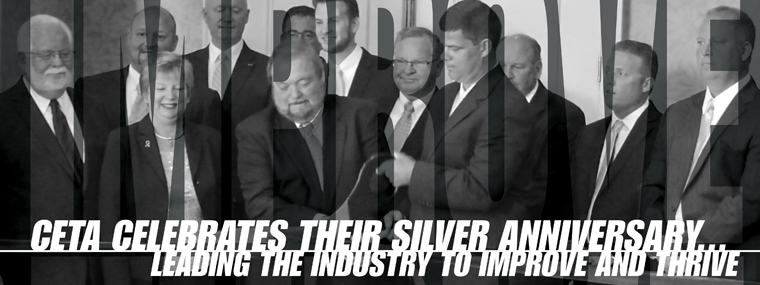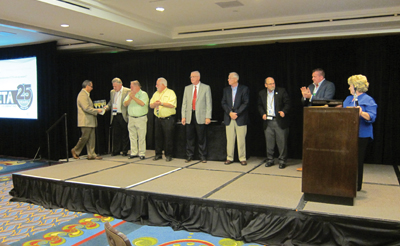
CETA Celebrates Their Silver Anniversary:
Leading the Industry to Improve and Thrive
By Diane M. Calabrese / Published October 2015

Silver anniversaries sparkle in a special way, marking a quarter century. They pull us back to rethink, and they push us forward to reengage. We recall the difficulties and reconsider the possibilities.
In 1990, the Cleaning Equipment Trade Association (CETA) got its official start. Twenty-five years later, there have been many memorable moments and changes, too. The constant has been the focus.
Linda Chappell, president of CETA, sums it up best in a recent letter to members: “Since its inception in March 1990, CETA has been an organization focused on bringing together manufacturers, distributors, and suppliers to the benefit of all three groups. By facilitating opportunities for members to communicate about trends, keep pace with new technologies, track business growth, and identify new product niches, CETA has fostered all the good that comes from synergy.”
That synergy emerges in every conceivable form. Often, it happens when members are hard at work on an issue, such as at a board meeting. “At a recent board meeting, we were discussing the future of CETA, and I had the distinct pleasure of listening to Roy Chappell of Chappell Supply in Oklahoma City speak about the history of CETA,” says Aaron Lindholm, president, MTM Hydro, Inc. in Eden Prairie, MN. “The reason this stands out in my mind is that in the room were leaders of the industry, people with many years of experience, but when Chappell spoke, everyone listened, it was very quiet and it just showed a lot of respect for Chappell and the history of CETA.”
The interlude made a profound impression on Lindholm. “It was one of those had-to-be-there moments, but the silence from all the other board members is what I remember,” he explains, pointing to their quiet acknowledgement of the good fortune to be present and directly link present and past.
“Some of my strongest memories of being on the board would definitely be the friendships and long-term contacts you make,” says Curtis Braber, president, BE Pressure Supply in Abbotsford, BC, Canada. “It’s a great feeling knowing you can always pick up the phone and make a call to someone who probably has an answer or understanding of the challenge you may be facing.”
There is strength in CETA. “With so many members that have upwards of 40 years of experience in the industry, they have faced most challenges and seen the industry evolve so that their insight is invaluable,” explains Braber.
Beginnings and Changes
In its September 2010 issue, Cleaner Times reprinted an article from the November 1990 issue, which was written by Erin McCarthy Taylor. The article offers a thorough account of the origin of CETA, including its root that extends to CEMA [Cleaning Equipment Manufacturers Association]. We recommend revisiting the article at cleanertimes.com/pdfdocs/CETA 1990.pdf for a thorough review of the history of CETA.
Tim Layden, the owner of High PSI, Ltd. in Glendale Heights, IL, was among the group that met in Las Vegas, NV in 1989, a gathering that led to the beginning of CETA. The meeting included representatives from manufacturers, distributors, and suppliers.
“Bill Lindsey of LA Products represented the manufacturers,” says Layden. “Mike Christopherson of General Pump represented the suppliers. I represented APD [Associated Pressure Washer Distributors], as the president. We discussed the best way to represent the industry.”
Although Lindsey, Christopherson, and Layden took the lead in the discussion, there were many discussants who met, with each of the men supported by five representatives from his industry sector. The discussion about how to apportion board seats in a new organization, which would become CETA, was somewhat difficult and required negotiation. In the end, the give and take resulted in four manufacturers, three distributors, and three supplier members on the first board.
Any organization experiences difficulties from time to time. Attaining good representation from both manufacturers and distributors has long been a goal of Layden. When manufacturers encourage their
distributors to join and get involved in CETA, it is a good thing, he explains.
Being part of CETA is a good experience in multiple ways. And as members reflect on the 25-year anniversary, each will recall something a little different. Many though will echo Layden’s sentiment. “The biggest advantage of CETA is the friends and business associations that I have made over the years,” he says.
At 25, CETA has seen children of members choose to enter the industry. Kim Micha, a current board member, is one example. Micha, a CPA and a principal at High PSI Ltd., is Layden’s daughter.
Micha has a special vantage, being able to tap Layden for firsthand accounts of the early years of CETA, and looking forward to more changes. What would she most like to see when she envisions CETA at 30 years?
“I would like to see active membership increase, meaning more people attend the annual PowerClean shows,” says Micha. “The upcoming show October 20–23 in Vegas is shaping up to be one of the best yet. It is kicking off on Tuesday with keynote speaker Barry Maher and the reception Tuesday night will be at the Mirage’s Dolphin Pool.”
Micha adds that she also hopes to see more members participate in benchmarking. “It is a fantastic benefit that allows you to assess your business by the numbers,” she explains.
 Across the years, there have been many changes at CETA. A very recent one garners lots of comment. “Com-bining our shows with ISSA has made the annual PowerClean event bigger and better than ever,” says Micha. Lindholm agrees. “MTM Hydro has been a member of CETA for more than 15 years,” he says. “The biggest change was co-exhibiting with ISSA for the annual exhibition again in 2015.”
Across the years, there have been many changes at CETA. A very recent one garners lots of comment. “Com-bining our shows with ISSA has made the annual PowerClean event bigger and better than ever,” says Micha. Lindholm agrees. “MTM Hydro has been a member of CETA for more than 15 years,” he says. “The biggest change was co-exhibiting with ISSA for the annual exhibition again in 2015.”
The first co-location of the CETA annual trade show, PowerClean, with ISSA/INTERCLEAN took place in 2014. The intentional melding—but not fusing—of venues and forums of the two groups has had a very positive effect on CETA, says Lindholm. And accomplishing the outcome was not a walk in the park. “It took a lot of effort from many people, and I for one appreciate and respect the change tremendously,” he explains.
Recalling his experiences with CETA, Braber is optimistic that change occurs as needed and makes the organization ever-more robust. “I have been a CETA member for 18 years, and have watched it evolve,” he says.
“Seeing so much consolidation in the manufacturing members of CETA has been one of the biggest changes, but recently we have seen a resurgence of new, smaller manufacturers getting into the business,” says Braber. “And this shows when you look at the growth we have had in the past couple of years at the CETA annual convention with new exhibitors.”
Present and Future
The opportunities to learn through CETA are significant. “As the incoming president of CETA this year, I am often asked, ‘What is the value of CETA?’” says Braber. “And although there are many to choose from, one of the clearest answers is ‘education’.”
The rigor of the sessions at the annual meeting is outstanding. “Coming to the annual convention is the best way to gain valuable insight in keeping up with new regulations, technical training, and best business practices,” says Braber.
“If people cannot attend the shows, there are live webinars and archived education opportunities on the CETA website, too,” says Micha. “This benefit will only increase as the new CETA website now has the capabilities to host these sessions on the member’s only portion of the site.”
Lindholm wishes more members and prospective members knew about benchmarking. “Benchmarking, in my opinion, is a phenomenal way to know how your business is doing compared to the businesses of your peers,” he says.
“With the type of information that benchmarking supplies a business owner, it can really help drive growth and change for a small business owner, which in today’s business environment, even the slightest of advantages can make big differences,” explains Lindholm. “This is what benchmarking can offer: advantages, collaboration, and growth potential.”
Most definitely, all should know that CETA is a welcoming as well as an invigorating association. “This is my first year on the board and really our company’s first year in being involved in recent history,” says Ben Hagemann, purchasing manager at American Pressure in Robbinsdale, MN. “I was excited to see how kind and welcoming the people on the board of directors are.”
Hagemann explains that he had a few “misconceptions” that were “quickly corrected.” The wide view of the industry that CETA has is important. “Everyone is very forward looking,” says Hagemann. “Personal and company agendas are set aside for the benefit of the whole industry…” he emphasizes. In addition, there is a “good attitude toward service.”
The dedication with which board members and managing director, Debbie Murray, who is assisted by Tracy Wagoner, work deserves mention, too. “I am impressed with the efforts to improve the organization and develop products that provide real benefits to members,” says Hage-mann. “The organization is headed in a great direction right now.”
Some things will not change. “One of the benefits to belonging to CETA is what CETA does for you—education, displays, articles, etc.,” says Hagemann. Another real benefit, too often not realized, explains Hagemann, is the collaboration that occurs on behalf of the industry, or “working for the industry” in ways an individual could not. “The people at CETA and its committees are able to make significant advances where individual or groups of companies would not get an audience.”
The work that CETA does should receive much higher visibility in the future. That in itself would be a recruitment tool for members. “As a group, CETA can ensure that products are sold and able to be used,” says Hagemann. “CETA fights against un-needed regulations, and as an organization works to help everyone in our industry both survive and thrive, while at the same time helping develop standards and regulations that move the industry forward.”
Being active in CETA brings rewards of many kinds. “As I have been involved, I have realized how crucial these efforts of CETA are to our day-to-day business,” says Hagemann. “I think that these efforts of CETA alone justify the membership our company has.”
As he looks forward to 2020, Lindholm would like to see more of all that’s good about CETA. “That means a continuance of the direction we are headed in, as the group is healthy financially,” he says. “We are investing in added benefits for the members and really would like to see increased participation and membership enrollment.”
Growth brings new ideas, ties, and, of course, synergistic possibilities. “When I think about CETA in the future, my hope is more growth,” says Braber. “We have been seeing an in-crease in membership in recent years as more distributors realize the valuable tools they gain from membership. And the more growth we have—along with higher attendance at the annual show— the more flexibility the board has to add even more education programs.”
To be sure, optimism prevails among CETA board members. “In five years, I anticipate CETA will have a much larger membership, as CETA continues to lead the way for our industry to improve and thrive,” says Hagemann.
Improve. Thrive. These two words sum up nicely the essence of CETA at 25.




